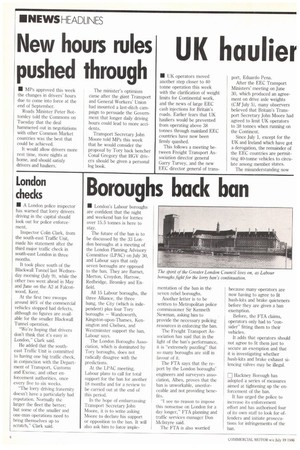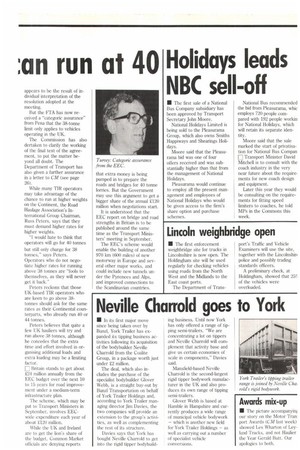Boroughs back ban
Page 6

Page 7

If you've noticed an error in this article please click here to report it so we can fix it.
• London's Labour boroughs are confident that the night and weekend ban for lorries over 15.5 tonnes is here to stay.
The future of the ban is to be discussed by the 33 London boroughs at a meeting of the London Planning Advisory Committee (LPAC) on July 30, and Labour says that only seven boroughs are opposed to the ban. They are Barnet, Merton, Croydon, Harrow, Redbridge, Bromley and Enfield.
All 15 Labour boroughs, the three Alliance, the three hung, the City (which is independent) plus four Tory boroughs — Wandsworth, Kingston-upon-Thames, Kensington and Chelsea, and Westminster support the ban, Labour says.
The London Boroughs Association, which is dominated by Tory boroughs, does not radically disagree with the predictions.
At the LPAC meeting, Labour plans to call for total support for the ban for another 18 months and for a review to be carried out at the end of this period.
In the hope of embarrassing Transport Secretary John Moore, it is to write asking Moore to declare his support or opposition to the ban. It will also ask him to force imple
mentation of the ban in the seven rebel boroughs.
Another letter is to be written to Metropolitan police commissioner Sir Kenneth Newman, asking him to provide the necessary policing resources in enforcing the ban.
The Freight Transport Association has said that in the light of the ban's performance, it is "extremely puzzling" that so many boroughs are still in favour of it.
The FTA says that the report by the London boroughs' engineers and surveyors association, Albes, proves that the ban is unworkable, unenforceable and not providing benefits.
"I see no reason to impose this nonsense on London for a day longer," ["TA planning and traffic services manager Don McIntyre said.
The FTA is also worried because many operators are now having to agree to fit hush-kits and brake quieteners before they are given a ban exemption.
Before, the FIA claims, operators only had to "consider" fitting them to their vehicles.
It adds that operators should not agree to fit them just to secure an exemption and that it is investigating whether hush-kits and brake exhaust silencing valves may be illegal.
[I] Hackney Borough has adopted a series of measures aimed at tightening up the enforcement of the ban.
It has urged the police to increase its enforcement effort and has authorised four of its own staff to look for offenders and initiate prosecutions for infringements of the ban. appears to be the result of individual interpretation of the resolution adopted at the meeting.
But the ETA has now received a "categoric assurance" from Pena that the 38-tonne limit only applies to vehicles operating in the UK.
The Commission has also dertaken to clarify the working of the final text of the agreement, to put the matter beyond all doubt. The Department of Transport has also given a further assurance in a letter to CM (see page 26).
While many TIR operators may take advantage of the chance to run at higher weights on the Continent, the Road Haulage Association's International Group Chairman, Russ Peters, says that they must demand higher rates for higher weights.
"I would hate to think that operators will go for 40 tonnes but still only charge for 38 tonnes," says Peters. Operators who do not negotiate higher rates for running above 38 tonnes are "fools to themselves, as they will never get it back."
Peters reckons that those UK-based TIR operators who are keen to go above 3Stonnes should ask for the same rates as their Continental counterparts, who already run 40 or 44 tonnes.
Peters believes that quite a few UK hauliers will try and run above 38 tonnes, although he concedes that the extra time and effort involved in organising additional loads and extra loading may be a limiting factor.
Britain stands to get about £2,1 million annually from the EEC budget over the next 10 to 15 years for road improvement under a medium-term infrastructure plan.
The scheme, which may be put to Transport Ministers in September, involves EECwide expenditure each year of about £120 million.
While the UK and Ireland are to get the lion's share of the budget, Common Market officials are denying reports that ektra money is being pumped in to prepare the roads and bridges for 40 tonne lorries. But the Government may use this argument to get a bigger share of the annual £120 million when negotiations start.
It is understood that the EEC report on bridge and road strengths in Britain is to be published around the same time as the Transport Ministers' meeting in September.
The EEC's scheme would enable the building of another 970 km (600 miles) of new motorway in Europe and several other major works, and could include new tunnels under the Pyrenees and Alps, and improved connections to the Scandinavian countries.




























































































